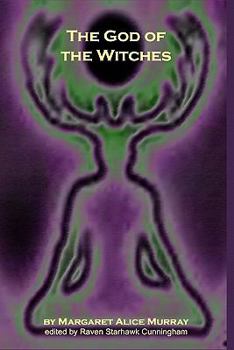The God Of The Witches
Select Format
Select Condition 
Book Overview
"An important and fascinating book."--New Statesman and Nation "A book of absorbing interest."--Psychic News This celebrated study of witchcraft in Europe traces the worship of the pre-Christian and... This description may be from another edition of this product.
Format:Paperback
Language:English
ISBN:1438242557
ISBN13:9781438242552
Release Date:June 2008
Publisher:Createspace Independent Publishing Platform
Length:130 Pages
Weight:0.44 lbs.
Dimensions:0.3" x 6.0" x 9.0"
Customer Reviews
5 ratings
A New View of "Dark Age" History
Published by Thriftbooks.com User , 15 years ago
This book is a real eye opener; Dr.Murray contends that the "Old Religion" did NOT die off instantly with the introduction of Christianity, but lingered for a thousand years, well into historical times. With scholarly research, she presents compelling evidence that historical people, and historical events were in fact, Pagan. Like St. Joan D' Arc, acting out the "Death of a King" scenario. Highly recommended, to modern day Pagans, and history and anthropology students alike!
A book of religion, not a book about religion
Published by Thriftbooks.com User , 16 years ago
We would do well, at a remove of about 80 years to consider Margaret Murray's The God of the Witches as a religious document in itself. It propounded the idea that there was a remnant of paganism that was practiced in Europe despite the domination by and opposition of the Church. At the time of its writing, the dominant idea was that the persecution of witchcraft was a wholly mendacious exercise of social control. Murray's book was a mild and necessary corrective. One of the results of her work was the contribution to the rise of contemporary paganism of a certain historical depth. This book matters because it mattered to many readers, not because it's correct. Lynn Hoffman, author of bang BANG
A very significant history - wrongly attacked by Cohn
Published by Thriftbooks.com User , 22 years ago
This book came out in the 1930s and was one of the firtst to take the testimony of women put on trial as witches seriously - she described a witchcraft practice that may have existed in part in the late medieval period - but which is very different from the Wicca or Craft revived in the 20th century. She may well be wrong in many parts, particularly on Joan - but the defamatory attack by Norman Cohn in his Europe's Innder Demons was completely out of order and wrong. He accused her of omitting from the testimony of the alleged witches that she quoted anything that they had said that would have discredited them. He quoted many samples of this... but I was astonished when I checked him against this book, to find that she had not omitted these passages but had considered them in detail! The passages moreover were not that discrditing - eg "I travelled to the fairy mound and there met the Queen of Elf who rules over the Craft." This is standard folklore and certainly does not prove the accused person was fraudulent in claiming to be in the Craft. Unfortunately Cohn's critique of Murray has been spread far and wide, particularly by Ronald Hutton who in his several books endorses Crohn's critique and says that it destroys Murray's credibility... Hutton was then quoted by many others who trusted him to have checked to see if Cohn was right...However this does not mean that Murray does not greatly need updating - she wrote after all in the 1930s - particularly she did not understand shamanic language - and much in the witchtrial testimonies reflects shamanistic ideas - see Carlo Ginzburg and also a book entitled Between the Living and the Dead by Pocs - published in 1999 - this is a study of 2000 witchtrials - by far the largest ever done - and she reports that Medieveal witchraft was inseparable from an indigenous local shamanic tradition - this is totally interwoven rigtht throughout her period and probably back to earlier times.So - `Murray made a start, - read her as a 1930s view.. she was brilliant for her time... - but as for her thesis that a pagan witchcraft survived, it may well be right some of- the witches she quoted may have possessed a truely old shamanic tradition.
Murray needs another look
Published by Thriftbooks.com User , 25 years ago
In the light of recent scholarship by researchers such as Carlo Ginzburg, Murray' supposedly "discredited" theories look a lot better today than they did in the 1970's. She needs to be reassessed in this light. It's a shame that Norman Cohn is so often seen as having made the definitive criticism; his own textual manipulations in the presentation of such documents as the Canon Episcopi make his accusations against Murray seem rather hollow. His major criticism of Murray is that he claims she left out mention of supposedly "impossible" elements in accounts by accused Witches, thus making their tales seem plausible. In fact, she did no such thing; her books are arranged thematicaly, and so these "impossible" elements are merely covered in other chapters. Further, "impossible" elements exist in the first-hand tales of believers in any religion; witness supposed "miracles" which still today are said to take place at the shrines of Christian saints.Murray's works need to be re-read and looked at afresh. It's time for a more rational and unbiased re-assessment.
A classic, but....
Published by Thriftbooks.com User , 28 years ago
Murray's work is one of the first examinations of historical pagan folk practices using techniques of the modern era. This work is one of the roots of the modern neopagan traditions, particularly Wicca, and deserves a spot on the bookshelf as such. Be aware, though, that Murray's academic standards were weak, and that some of this material does not accurately reflect current archaeological and/or neopagan thought







